Whilst I use the term solopreneur in this post, I’m also referring to consultants, fractional consultants, coaches and agency owners who are just starting on their journey.
Starting on the solopreneur journey can be daunting.
You’re essentially signing up for months of uncertainty until everything eventually clicks together.
You’ve got to work out what you’re selling, who you’re selling to and then how to deliver on the work sold.
For me, on my second solopreneur journey, I was able to approach my first 3-4 months differently than the first time.
Within 5 months of sending my first message, I had signed up 10 clients, most of which fit my ideal client profile (ICP) and have a steady pipeline for future clients in Q1 of 2024.
In this lengthy post, I’m going to share the exact system I used as well as the different tactics that led to signing up these clients.

As you can see in the diagram above, the overall system is comprised of:
I recommend that you follow the steps outlined below when starting out so that you focus on the channels and tactics that generate the quickest results.
Below you’ll see how quickly these tactics helped me generate interested leads.

Throughout the rest of this post I’ll walk you through how I thought about each channel/tactic and share how it generated pipeline for my solo consulting business – AgencySalesDesign.com (this website you’re on).
But before we dive into the tactics, let’s start with the foundation – your ideal customer profiles, buyer personas and offers.
Many people eager to get started skip this step.
Or at least think they know who they are selling to.
However, without doing the groundwork you will struggle to get consistent results and may end up attracting the wrong type of clients.
This hasn’t happened to me this time around, but I definitely remember working with terrible clients in the past.
One of which never paid me £5,000 – cheers Glenn.
Ideal Customer Profile (or ICP) is a term used to define the type of companies that you want to work with. For most companies, the product or service that you offer will likely resonate with particular companies…rather than all companies.
An ideal customer profile is not the same thing as a customer persona or user persona. You may want to develop several user personas as well – but not until after you’ve defined an ideal customer profile.
Determining your ideal customer allows you to figure out who you should be targeting with your marketing and sales efforts.
The more detailed your profile is, the more accurately you can zero in on the companies that are most in need of your service and most likely to give you their business.
When thinking about your ICP, you should consider the following:
It’s ok to have multiple ICP’s, however I would recommend targeting one ICP at a time – especially as a solopreneur.
These refer to the individuals within the companies that are your ICP.
The aim of buyer personas is to understand these individuals:
So you can produce content, messages and have conversations that resonate with their motivations and help them overcome their objectives and challenges.
It also helps you position you and your service as the solution that will soothe their pain.
Essentially, you use the information you gather from here to understand what messages and what value you can provide your prospects.
Below are some samples of how to get more detailed with your ideal buyer.
Having a clear understanding of your ICP and buyer personas ensures that your Sales / Marketing efforts are targeted and efficient.
It helps in creating more relevant and engaging content and also services that resonate with your target audience.
Understanding your client’s pain points and motivations allows you to tailor your approach to meet their specific needs, leading to higher conversion rates and customer loyalty.

For Agency Sales Design, my ICP and personas are pretty straight forward.
In summary, my ICP’s are
And my persona is the Agency Owner / Founder.
I also have the advantage of being my ICP and Persona, having run two agencies and co-founding one.
So this step was quite straightforward for me. However, I didn’t skip it.
When working through this process, here are a few things to consider:
Now, I struggle with this myself. And my offer has evolved over time (and still is).
So I am in now way an expert on this topic.
However, I do need to cover it for the purpose of this post.
Your offer is the product or service you are selling. It’s not just what you sell, but also how you present it, including the value proposition and the solution it provides to the customer’s problem.
It encompasses the features, benefits, and unique selling points that differentiate your offer from competitors.
Having a clear and compelling offer is crucial for attracting and retaining clients and it helps in communicating the value and relevance of your product or service.
A well-defined offer aligns with the needs and desires of your ideal customer, making it more likely to succeed.
When thinking about your offer, it’s worth noting that companies (and people) typically purchase for the following reasons:
In my opinion, the closer you are to helping people generate more money – the “easier” it is to sell your service.

FYI – This whole post is an example of me iterating on my offer.
Here are the steps I took to land on my offers:
There are a few people that helped shape how I thought about my offer:
As I mentioned, offer creation isn’t my strongest point. However I landed on two offers for my ideal clients.
I help Agency Owners generate more pipeline that results in revenue by:
Ok, so you’ve spent time on your ICP’s, personas and have validated some offers.
Now it’s time to tell the world!
This is perhaps the easiest step in landing your first few clients and it’s all about positioning.
If like most solopreneurs you sell to other businesses then LinkedIn is going to be the best channel for you to optimise.
Your profile needs to explain how your service solves the challenges your ideal clients are facing.
Simple enough right?
There are two things you need to update on LinkedIn, your personal profile and your company page.
This is the main real estate that you have to promote yourself.
If you haven’t already, feel free to check my profile out here: https://www.linkedin.com/in/markcolganmarketing/
Personally, I recommend turning on Creator Mode if you can as it gives you more features to improve your reach.
It also allows people to follow you without connecting (I’ve had a few calls with prospects that never connected or engaged with my profile, but were following the content I was producing).
You can also add profile topics (through hashtags) and unlocks a few other cool features like:

Once you’ve done this you can use the following checklist to ensure you’ve covered the basics.
The company page is often overlooked, but I feel it is worth spending a bit of time to make sure it is optimised.
As a solopreneur, you need to build credibility and having a complete company page will help you with this.
I used most of the same content and images as I used on my personal profile and also ensured that I filled in all of the fields so the profile was complete.
My advice here is to simply follow LinkedIn’s prompts and complete your profile, making sure that the links redirect to your website.
In the coming months I will spend more time posting content via the company page.
A little birdie told me that this is something that LinkedIn will be focusing on in 2024 – yet it is too early to tell at the moment.
Right, your profile is updated…time to “show me the money” right?
Let’s move onto referrals.
It’s overkill to design an end to end referral process at this stage.
In this section I’m going to talk about a very lean referral system, AKA an email to people in your close network.
I’ve always taken great pride in nurturing relationships with my “business friends”.
I continuously share content with them, I support their business endeavours, I buy their digital products, I check in on them, I make introductions whenever possible.
And when I visit London, I always put some money behind a bar and send an open invite to them all for a catch up.
Or I’ll do my best to grab a coffee or lunch when I’m in town / they’re visiting for an event.
There are some business friends I’ve never met in person, but catch up monthly and quarterly after Zoom.
These are people who I consider would “go to bat for me”.
And as I’ve topped up the goodwill jar over the years, I know I can reach out to them with an ask every once in a while.
As you get started in your solopreneur journey I would encourage you to also build your network of business friends.
Here are some places to start:
Once I’d updated my LinkedIn profile with the new positioning, I was ready to reach out to my “business friends”.
Here’s how I approached it:
Super simple and very effective.
I received several introductions from my network to ideal clients. One of which signed up to work with me.
Additionally a few of my “business friends” also fit my ideal client profile and my new messaging resonated with their pain points.
They also signed up to work with me.
This one tactic generated my first 3 paying clients.
Wohooo!
But I was hungry for more.
So I did what I know best…I went outbound, on LinkedIn!
But before I started pitch slapping people on LinkedIn, I wanted to make sure I had something valuable to offer.
It’s never a great idea to walk up to a stranger in a bar and ask them to marry you.
And it’s exactly the same when reaching out cold to a prospect.
The approach I like to take is to start the conversation off with value.
So I brainstormed a few content ideas which I call my Minimal Viable Content “MVC”.
Essentially this is valuable content (for my ideal clients) which doesn’t take me months to produce or have high production value.
It’s straight to the point and easy to implement.
Content formats you can consider are:
As I wrote the above, I do realise how easy I made this sound.
Having spent years in Marketing producing content across various formats definitely helped me here.
As of today, I’ve created several resources that I can use depending on the challenges of my personas.
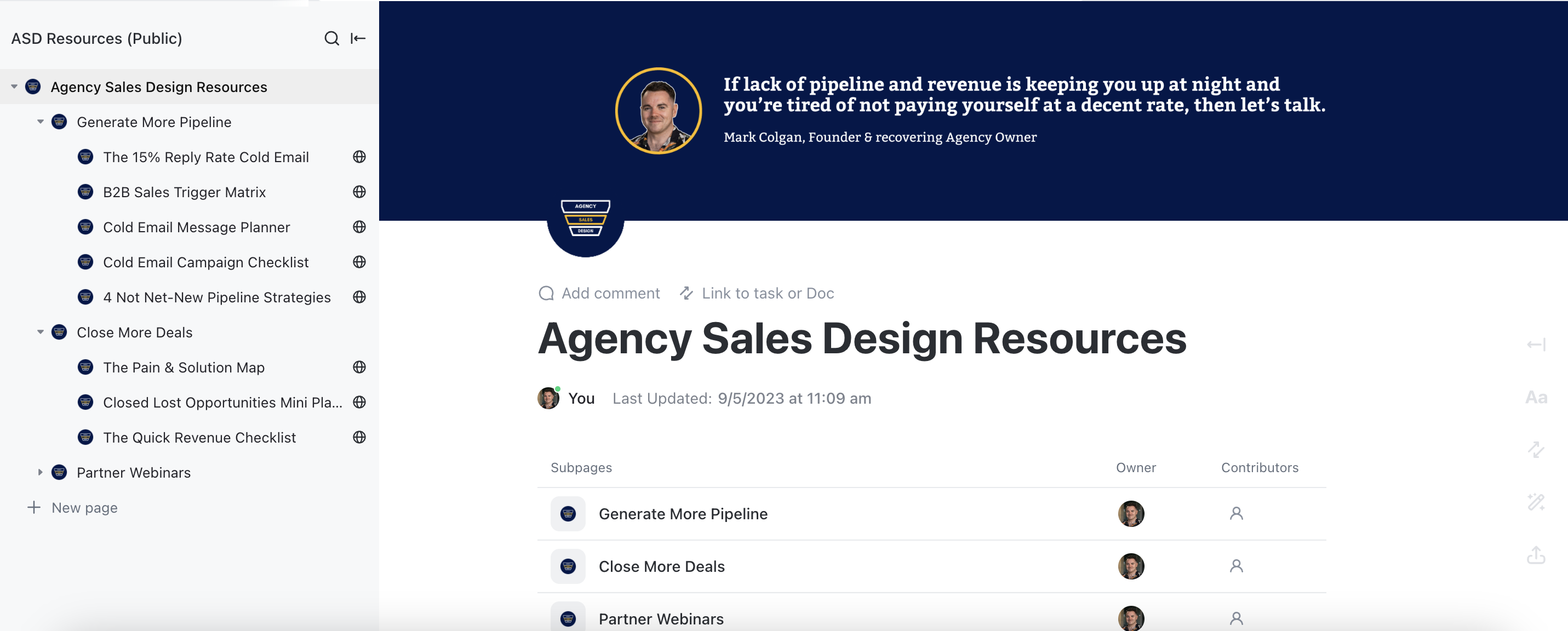
Now I had my MVP, I was ready to start spamming all my connections!
Of course, I’m joking here.
Reaching out directly on LinkedIn is one of the quickest ways to get a response.
Not everyone is as active on LinkedIn as you might be, but the majority of people who have a completed profile are likely to check LinkedIn at least once a week.
The aim of this tactic is to connect with and send messages to as many people that fit your ICP as you can.
However, you need to be mindful of LinkedIn’s current limits (as of Dec 2023):
In order to launch LinkedIn outreach I followed the following steps:
Over time, this generated several discovery calls. 3 of which converted into paying clients.
As I continue to refine my offer and produce more content, I will follow these steps each week in order to generate more calls.
We’re on a roll!
Let’s move onto partnerships.
I love partnerships. And I leveraged these types of relationships well in my last two agencies.
In my opinion, a lot of people, especially Solopreneurs, miss out on building strong partner networks around their services.
However, not all partners are created equally. Others have more motivation to partner with you.
The aim is to build a win-win-win scenario for everyone involved.
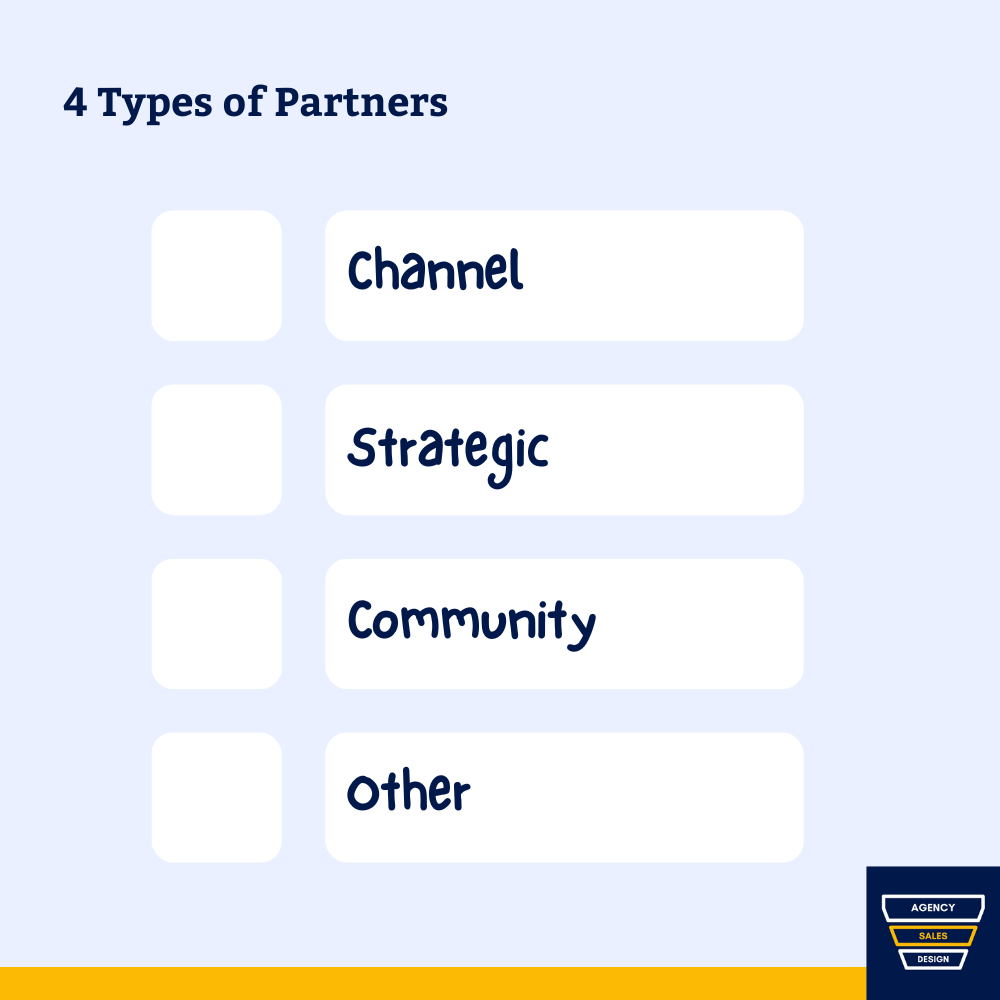
At a high level, there are 4 types of partners:
I’ll expand upon each one below.
Different categories of business (for example, a software company in your industry) and growing together.
Other agencies or companies that offer complementary services to the same clients in your industry.
Think about services before your clients work with you AND after they work with you.
Also, don’t discount your competitors (especially the more established/expensive ones).
This one is pretty self explanatory, but most industries and niches have communities.
Some may be run by competitors and others can seem a little unfriendly if you’re a “pesky agency trying to peddle your wares”.
But it’s definitely worth seeing if there is an opportunity to collaborate on content.
This is less of a direct sales play here, but showing up and providing value keeps you top of mind within the community members and the community owners/facilitators.
Simply search “niche” or “job role” AND community into Google to get started with these i.e. “Product Manager Community”.
This is more of a catch all category for partners that fall outside the channel, strategic and community partners.
Examples include VC’s / Accelerators / Revenue Based Financing companies or even individual consultants or coaches that work with your ideal clients.
Again, with the benefit of experience, I was able to quickly map out potential partners for my new business.
As a reminder, I’m helping agency owners with their sales. And there are tons of partners I could work with.
The first step was to create a spreadsheet, which I creatively called “Agency Land”,

I then allowed myself to fall down rabbit hole after rabbit hole looking for partners that would be a great match.
The next step was to then reach out to these potential partners to see if there was alignment and an opportunity to build a win-win-win partnership.
And there was, after a couple of months I have 3 official partners which led to:
A quick note on when it comes to finding new partners, here is a framework I’ve used in the past: Helps, Sells and Funds:
Now we’re cooking!
I continue to reach out to new potential partners each month.
These partnerships can have a compounding effect for opening up new doors for content collaborations and client work.
Talking of content…let’s get writing.
I remember working with a Marketing Agency 10 years ago and it took weeks to produce content and design graphics.
It was so frustrating, the back and forths, the miss-interpreted briefs, the delays!
A total nightmare.
Fast forward to today, where I literally opened my laptop a few hours ago as I was feeling inspired.
I’ve written over 4,000 words and produced several images in Canva.
And I’m still going.
Marvellous really.
Again, I’m not saying this should be as easy for you as it is for me. I understand that my background in Marketing gives me an advantage here.
But, content doesn’t have to be hard.
In fact, it can be easy when you write content that helps your clients overcome their challenges.
Let’s dive in…
Consistently creating high-quality, informative content and sharing it where your prospects spend time allows you to showcase your knowledge and expertise in your field.
This helps in building trust and credibility with your audience and leads to increased respect and recognition within your industry.
For me, content has always been about building relationships.
I aim to create content that resonates with my ideal clients in an attempt to foster deeper engagement that goes beyond a transactional relationship.
I leave easter eggs all over my profile and in the content. I use (some) of the same language that you’d hear from me if we were two pints in at the pub.
I try to write as I speak, this (I think) creates authenticity and trust.
I’m not for everyone, and everyone isn’t for me. Afterall, we’re working for ourselves now so we can do awesome stuff with great people right?
Anywho, I got a bit distracted.
Another benefit of creating quality content is leads! By targeting content to your ideal clients, you attract the right audience, leading to higher-quality leads.
These leads are more likely to be interested in your products or services, increasing the chances of conversion.
If you’re still on the fence about creating content, then let me share a huge risk of not doing so.
You simply won’t be seen by prospects who are actively searching for solutions that you could provide.
And if you’re lucky enough to be seen, you may not be trusted – as you’re not putting out the trust signals (via content).
In summary, a lack of presence can lead to lower brand awareness and less revenue.
Didn’t mean to get so serious there, let’s move onto a more positive note…getting started with creating content.
There’s a few ways to create content. The easiest way is to just take news articles that relate to your service/industry and share them.
You can take this one step further by adding your commentary on these news articles/updates.
However, the best content for you to focus on is organic content that you create yourself.
Here’s how I went from a blank piece of paper to over 30 content ideas…
I imagined I was writing a book on the problem I was solving for my clients. Below are the steps I went through:
I wasn’t aiming for perfection here, I just wanted to get it all out of my head and down on paper.
By the end of this exercise I had over 30 ideas for content.
For each piece of content I could expand even more by thinking about how to make it more valuable:
Oh and you need to share the content.
Try not to overthink this.
I aim to share a minimum of 4 posts on LinkedIn each work week.
If you’re just getting started, aim for 1 post a week, then 2 and work your way up.
Also, some of the content you create can be repurposed for Step 4: Minimal Viable Content (MVC) campaigns in the future.
Additionally, you can take the same content and build out a resource library on your website.
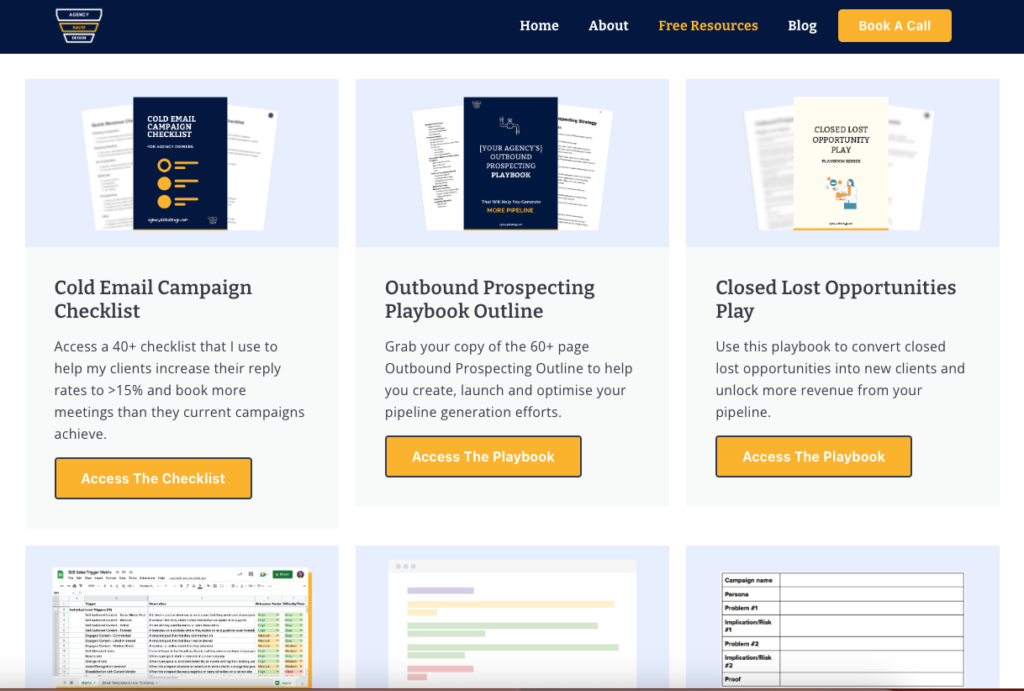
My content prompted several people to reach out, with 2 open deals in the pipeline for Q1 2024.
But I know what you’re thinking…
Ok Mark “Mr Outbound” – why haven’t you sent any emails to generate revenue?
I’ll expand on this in the next step.
Outbound only really works when you know what you’re selling.
And in the first 3 months, I was still working this out.
I was listening to my ideal clients’ challenges, testing my assumptions and trying to find out what my “no brainer” offer would be.
And the reality is…I think I’ll always be iterating on my offers.
But anyway, outbound.
When I work with established agencies, they’ve already found service-market fit.
And at this stage I recommend that running outbound campaigns is one of the first strategies they should implement.
However, when you’re still focussing on your first 10 clients, I believe that outbound should be last OR when you’re confident that you’ve found service-market fit.
If you’re unsure whether outbound campaigns are right for you, here are a couple of things to consider.
Cold emailing allows you to directly reach potential clients, much faster than most other channels (including those mentioned above).
It’s also pretty cost-effective. It doesn’t require a large budget, making it ideal for solopreneurs with limited resources.
After the initial planning and setup of your campaigns, you can contact a large number of potential clients without incurring substantial expenses.
Additionally, it scales like a dream. Once you’ve found a message that resonates and you have a great source of leads, you can send emails 24/7.
If you decide to not use outbound campaigns, you might miss out on the chance to connect with potential clients who are not reached through other marketing channels.
Sold on outbound yet?
If so, read on.
It’s worth noting, that as I write this post, I’m in the process of setting up my outbound campaigns for AgencySalesDesign.com.
Here’s what I’m doing:
I’ll be pressing launch in January once everyone is back at their desks.
The goal is for my outbound email campaigns to work alongside my other activities like partnerships, referrals, LinkedIn outreach and content.
When I opened up a blank Google Doc a few hours ago, I did not expect to write almost 5,000 words.
So thanks for joining me on this journey.
To quickly recap for those still with me.
If you’re a Solopreneur (or consultant, fractional consultant, coach, new agency owner) you need an interconnected system in order to generate your first 10 clients.
My first 10 paying clients came from this system (see below):
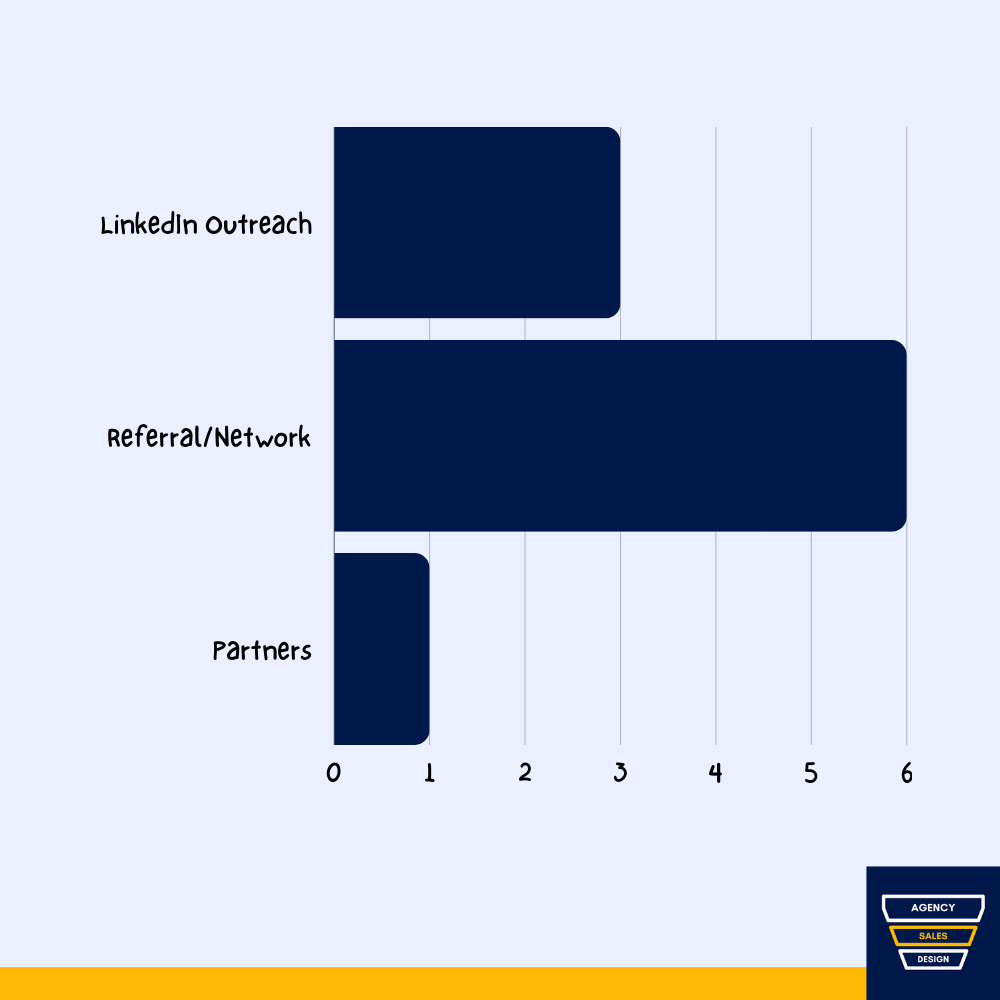
To replicate the system:
There are of course other strategies to acquire clients in the early stages, but this is what worked for me (and a few others I’ve spoken to).
Life as a solopreneur can be pretty tough. The ups and downs can be challenging to navigate whilst also staying sane.
Stick with it, implement the above and enjoy the freedom solopreneurship can bring.
If you liked this content, I’d love to hear from you. Send me an email at [email protected].
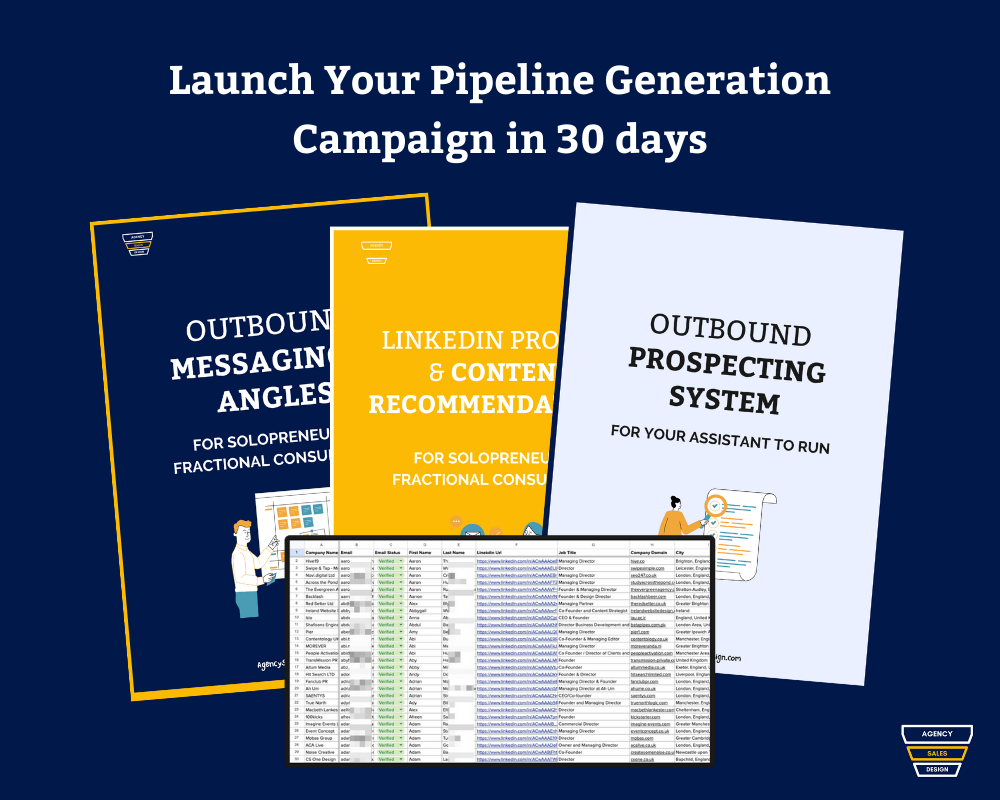
I’ll help you implement your Pipeline Generation System and give you everything you need to generate replies and book meetings with your ideal clients.
Including: